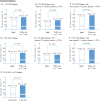Percutaneous Coronary Intervention Versus Optimal Medical Therapy for Chronic Total Coronary Occlusion With Well-Developed Collaterals
- PMID: 28903939
- PMCID: PMC5634287
- DOI: 10.1161/JAHA.117.006357
Percutaneous Coronary Intervention Versus Optimal Medical Therapy for Chronic Total Coronary Occlusion With Well-Developed Collaterals
Abstract
Background: The impact of percutaneous coronary intervention (PCI) on chronic total occlusion in patients with well-developed collaterals is not clear.
Methods and results: A total of 640 chronic total occlusion patients with collateral flow grade ≥2 were divided into 2 groups; chronic total occlusion patients either treated with PCI (the PCI group; n=305) or optimal medical therapy (the optimal medical therapy group; n=335). To adjust for potential confounders, a propensity score matching analysis was performed. Major clinical outcomes were compared between the 2 groups up to 5 years. In the entire population, the PCI group had a lower hazard of myocardial infarction (hazard ratio [HR], 0.177; P=0.039; 95% confidence interval [CI], 0.03-0.91) and the composite of total death or myocardial infarction (HR, 0.298; P=0.017; 95% CI, 0.11-0.80); however, it showed higher hazard of target lesion revascularization (HR, 3.942; P=0.003; 95% CI, 1.58-9.81) and target vessel revascularization (HR, 4.218; P=0.001; 95% CI, 1.85-9.60). After propensity score matching, a total of 158 matched pairs were generated. Although the PCI group showed a higher hazard of target lesion revascularization (HR, 2.868; P=0.027; 95% CI, 1.13-7.31) and target vessel revascularization (HR=2.62; P=0.022; 95% CI, 1.15-5.97), it still exhibited a lower incidence of the composite of total death or myocardial infarction (HR, 0.263; P=0.017; 95% CI, 0.087-0.790). The mean ejection fraction was improved from 47.8% to 51.6% (P<0.001) after PCI.
Conclusions: In our study, successful revascularization by PCI for chronic total occlusion lesions with well-developed collaterals was associated with lower incidence of death and myocardial infarction, improved left ventricular function, but increased repeat revascularization rate.
Keywords: chronic total occlusion; collateral circulation; medical therapy; percutaneous coronary intervention.
© 2017 The Authors. Published on behalf of the American Heart Association, Inc., by Wiley.
Figures





Similar articles
-
Long-term clinical outcomes of successful versus unsuccessful revascularization with drug-eluting stents for true chronic total occlusion.Catheter Cardiovasc Interv. 2011 Sep 1;78(3):346-53. doi: 10.1002/ccd.23019. Epub 2011 Mar 30. Catheter Cardiovasc Interv. 2011. PMID: 21452248
-
Five-Year Outcomes of Successful Percutaneous Coronary Intervention with Drug-Eluting Stents versus Medical Therapy for Chronic Total Occlusions.Yonsei Med J. 2018 Jul;59(5):602-610. doi: 10.3349/ymj.2018.59.5.602. Yonsei Med J. 2018. PMID: 29869458 Free PMC article.
-
Impact of Collateral Circulation on Survival in ST-Segment Elevation Myocardial Infarction Patients Undergoing Primary Percutaneous Coronary Intervention With a Concomitant Chronic Total Occlusion.JACC Cardiovasc Interv. 2017 May 8;10(9):906-914. doi: 10.1016/j.jcin.2017.01.026. JACC Cardiovasc Interv. 2017. PMID: 28473112
-
Optimal medical therapy vs. coronary revascularization for patients presenting with chronic total occlusion: A meta-analysis of randomized controlled trials and propensity score adjusted studies.Catheter Cardiovasc Interv. 2019 May 1;93(6):E320-E325. doi: 10.1002/ccd.28037. Epub 2018 Dec 13. Catheter Cardiovasc Interv. 2019. PMID: 30549199
-
Percutaneous Coronary Intervention With Drug-Eluting Stent Versus Optimal Medical Therapy for Chronic Total Occlusion: Systematic Review and Meta-Analysis.Angiology. 2019 Nov;70(10):908-915. doi: 10.1177/0003319719858823. Epub 2019 Jun 30. Angiology. 2019. PMID: 31256614
Cited by
-
Impact of collateralisation to a concomitant chronic total occlusion in patients with ST-elevation myocardial infarction: a subanalysis of the EXPLORE randomised controlled trial.Open Heart. 2018 Jul 16;5(2):e000810. doi: 10.1136/openhrt-2018-000810. eCollection 2018. Open Heart. 2018. PMID: 30057768 Free PMC article.
-
Impact of complete revascularization on long-term clinical outcomes in patients with multi-vessel disease, including chronic total occlusion.Heart Vessels. 2025 May;40(5):380-390. doi: 10.1007/s00380-024-02484-5. Epub 2024 Nov 29. Heart Vessels. 2025. PMID: 39609270
-
Percutaneous Coronary Intervention Versus Medical Therapy for Chronic Total Occlusion of Coronary Arteries: A Systematic Review and Meta-Analysis.Curr Atheroscler Rep. 2019 Aug 9;21(10):42. doi: 10.1007/s11883-019-0804-8. Curr Atheroscler Rep. 2019. PMID: 31399762 Free PMC article.
-
Original Article--Value of Pathological Q Waves and Angiographic Collateral Grade in Patients Undergoing Coronary Chronic Total Occlusion Recanalization: Cardiac Magnetic Resonance Study.J Saudi Heart Assoc. 2021 Apr 15;33(1):41-50. doi: 10.37616/2212-5043.1239. eCollection 2021. J Saudi Heart Assoc. 2021. PMID: 33880327 Free PMC article.
-
Development and Validation of a Novel Nomogram to Predict Improved Left Ventricular Ejection Fraction in Patients With Heart Failure After Successful Percutaneous Coronary Intervention for Chronic Total Occlusion.Front Cardiovasc Med. 2022 Apr 14;9:864366. doi: 10.3389/fcvm.2022.864366. eCollection 2022. Front Cardiovasc Med. 2022. PMID: 35514438 Free PMC article.
References
-
- Suero JA, Marso SP, Jones PG, Laster SB, Huber KC, Giorgi LV, Johnson WL, Rutherford BD. Procedural outcomes and long‐term survival among patients undergoing percutaneous coronary intervention of a chronic total occlusion in native coronary arteries: a 20‐year experience. J Am Coll Cardiol. 2001;38:409–414. - PubMed
-
- Morino Y, Kimura T, Hayashi Y, Muramatsu T, Ochiai M, Noguchi Y, Kato K, Shibata Y, Hiasa Y, Doi O, Yamashita T, Morimoto T, Abe M, Hinohara T, Mitsudo K; J‐CTO Registry Investigators . In‐hospital outcomes of contemporary percutaneous coronary intervention in patients with chronic total occlusion insights from the J‐CTO Registry (Multicenter CTO Registry in Japan). JACC Cardiovasc Interv. 2010;3:143–151. - PubMed
-
- Wilson WM, Walsh SJ, Yan AT, Hanratty CG, Bagnall AJ, Egred M, Smith E, Oldroyd KG, McEntegart M, Irving J, Strange J, Douglas H, Spratt JC. Hybrid approach improves success of chronic total occlusion angioplasty. Heart. 2016;1–8. - PubMed
-
- Mehran R, Claessen BE, Godino C, Dangas GD, Obunai K, Kanwal S, Carlino M, Henriques JP, Di Mario C, Kim YH, Park SJ, Stone GW, Leon MB, Moses JW, Colombo A; Multinational Chronic Total Occlusion Registry . Long‐term outcome of percutaneous coronary intervention for chronic total occlusions. JACC Cardiovasc Interv. 2011;4:952–961. - PubMed
-
- Olivari Z, Rubartelli P, Piscione F, Ettori F, Fontanelli A, Salemme L, Giachero C, Di Mario C, Gabrielli G, Spedicato L, Bedogni F, TOAST‐GISE Investigators . Immediate results and one‐year clinical outcome after percutaneous coronary interventions in chronic total occlusions: data from a multicenter, prospective, observational study (TOAST‐GISE). J Am Coll Cardiol. 2003;41:1672–1678. - PubMed
Publication types
MeSH terms
Substances
LinkOut - more resources
Full Text Sources
Other Literature Sources
Miscellaneous

